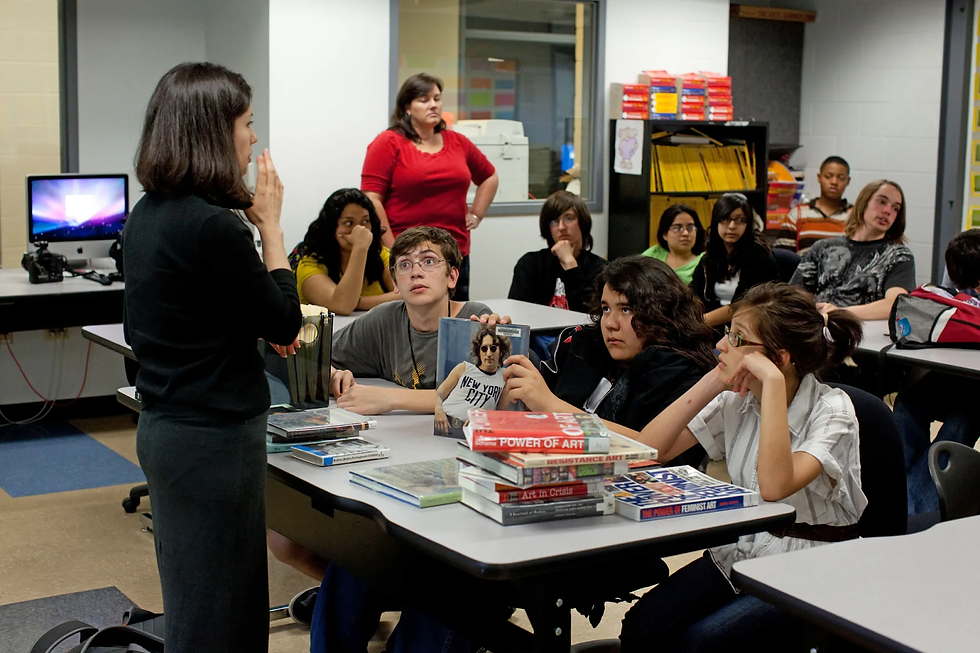Top 10 Lessons from the Dual Teacher Model for Educators
- Basil George
- Dec 5, 2024
- 3 min read
Education is constantly evolving, and new strategies are always being explored on how to improve teachers' connections with the students. One such approach gaining popularity is the Dual Teacher Model, where two educators share teaching responsibilities in the same classroom. This method has been proven to be beneficial not only for students but also for the teachers involved. Let’s explore what the Dual Teacher Model is, its key benefits, and the lessons educators can take from it.

What is the Dual Teacher Model?
The Dual Teacher Model, also known as co-teaching or team teaching, involves two teachers working side by side in a classroom. They plan lessons together, teach as a team, and assess students collaboratively. Here are some ways this model can be applied:
Team Teaching: Both teachers lead the lesson together, offering diverse viewpoints.
Station Teaching: Teachers divide the class into groups and guide different activities.
Parallel Teaching: The class splits into two groups, with each teacher delivering the same content simultaneously.
Alternative Teaching: One teacher focuses on a smaller group of students who need extra support, while the other instructs the larger group
Why is the Dual Teacher Model Important?
1. Encourages Collaboration
Teachers often work alone, but this model promotes teamwork. By sharing ideas and learning from each other, educators develop professionally and find fresh ways to engage students.
2. Reduces Teacher Burnout
Teaching is demanding, but having a co-teacher to share the workload helps reduce stress. It’s easier to manage tasks, avoid overworking, and it creates a better work-life balance.
3. Improves Classroom Management
Two teachers mean more hands to help with managing the class. While one leads the lesson, the other can address individual needs, handle disruptions, or support students who are struggling.
4. Provides Specialised Support
Each teacher brings unique strengths to the classroom. For instance, one might focus on supporting children with special needs while the other dives into subject-specific expertise. This means all students get the targeted support they need to thrive.
5. Builds Stronger Student-Teacher Relationships
When two teachers are in a classroom, students can receive more individual attention. This helps teachers understand each child’s learning style and create personalised learning experiences, promoting stronger bonds and improving engagement.

What Can Educators Learn from the Dual Teacher Model?
6. Teamwork is Key
The Dual Teacher Model highlights the importance of teamwork in education. Teachers can share ideas, gain constructive feedback, and improve their teaching methods.
7. Adaptability is Crucial
Co-teaching requires flexibility. Teachers must adapt to their partner’s teaching style and work collaboratively. This adaptability can improve their own skills and help meet the diverse needs of students.
8. Lessons are More Personalised
With two educators, lessons can be tailored to meet individual learning styles. This ensures that no child is left behind, and students of all abilities receive the attention they deserve.
9. Promotes Inclusion
The model supports inclusive education. Students with special needs or different learning paces benefit from specialised attention, while the rest of the class continues to learn effectively.
10. Redefines Professional Growth
The Dual Teacher Model isn’t just about sharing responsibilities. It’s also an opportunity for teachers to learn from each other, experiment with new techniques, and grow together as professionals.
The Bigger Picture
The Dual Teacher Model offers benefits that go beyond the classroom. For students, it creates a more inclusive and engaging environment. For teachers, it’s a chance to grow, share the workload, and feel supported. By promoting collaboration, encouraging adaptability, and focusing on the individual needs of the learners, this approach paves the way for better education outcomes for everyone involved.
Conclusion
The Dual Teacher Model proves that teaching doesn’t have to be a solitary effort. By embracing collaboration and sharing responsibilities, educators can create a more dynamic and effective learning environment. Whether it’s improving classroom management or reducing stress for teachers, this model has a lot to offer. If schools are ready to embrace this change, the Dual Teacher Model could be a game-changer for modern education.
The KCITE Teacher Education Programme aligns seamlessly with the principles of the Dual Teacher Model by promoting collaboration, innovation, and adaptability in teaching practices. This programme equips educators with the skills and strategies to implement effective co-teaching methods, enhancing classroom management and personalised learning experiences. By focusing on teacher development and teamwork, KCITE supports educators in creating dynamic learning environments where both teachers and students can thrive
References
Friend, M. (2014). Co-Teach! Building and Sustaining Effective Classroom Partnerships in Inclusive Schools. Brookes Publishing.
Murawski, W.W. (2010). Collaborative Teaching in Secondary Schools: Making the Co-Teaching Marriage Work!. Corwin Press.
Scruggs, T. E., & Mastropieri, M. A. (2017). The Inclusive Classroom: Strategies for Effective Instruction. Pearson.
https://www.edutopia.org/article/how-choose-co-teaching-model/




Comments